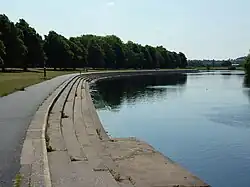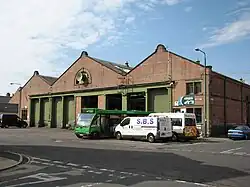Arthur Brown (engineer)



Arthur Brown M.Inst. C.E. (21 November 1851 - 13 April 1935)[1] was City Engineer for Nottingham, England from 1880[2] to 1919.
Life
He was born on 21 November 1851 in Nottingham, the son of George Hutchinson Brown a Nottingham merchant. He was educated at Nottingham Grammar School.
On 13 March 1877 at All Saints' Church, Nottingham he married Caroline Goodwin (1854-1919), only daughter of T.A. Goodwin of Nottingham, and they had the following children:
- Lieutenant Arthur Goodwin Brown M.T., A.S.C. (1878-1947)
- Lieutenant Ernest Victor Brown R.G.A. (b.1880)
- Ethel Carrie Brown (b. 1883)
- Winifred M. Brown (1888-1918) (drowned in the sinking of a ship)[3]
For many years he lived in Glenthorne, Lucknow Avenue, Nottingham. He died on 13 April 1935 and left an estate valued at £43,626 (equivalent to £3,825,200 in 2023).[4]
Career
He was articled to the Borough Engineer Marriott Ogle Tarbotton becoming Assistant Borough Engineer in 1874, and succeeded to the role himself in 1880. He retired in 1919.[5]
Works
- Gregory Boulevard, Nottingham 1882-83[6]
- Lenton Boulevard, Nottingham 1882-83[6]
- Radford Boulevard, Nottingham 1882-83[6]
- Beck Valley storm water culvert, St Ann's Well Road, Nottingham 1882-83[6]
- St Peter's Gate churchyard disinterments and improvements 1884[6]
- Cattle Market, London Road, Nottingham 1885[6]
- King Street and Queen Street, Nottingham 1890[6]
- Victoria Park, Nottingham 1894
- Sneinton Baths, Nottingham 1895[6]
- Victoria Embankment, Nottingham 1898[6]
- Construction works for Nottingham Corporation Tramways 1900 onwards[6]
- Talbot Street power station extension 1900[6]
- St Ann's Well Road power station 1901-02[6] and extension 1919[7]
- Carrington Street bridge,[6] 1904
- Stoke and Bulcote Sewage Farm extension[6]
- Bridge over the Nottingham Canal, Trent Street[6]
- Bridge over the Nottingham Canal, Wilford Street[6]
- Milton Street, Nottingham (widening)[6]
- Bath Street, Nottingham (widening)[6]
- Manvers Street, Nottingham (widening)[6]
- Bulwell Forest Cricket Ground
- Lenton recreation ground
- Wilford Suspension Bridge Nottingham 1906[8]
- Street works depot, Church Street, Basford 1907-08
- Goose Gate, Nottingham, (widening) 1911
- Carlton Road, Nottingham (widening between Thorneywood Lane and the city boundary) 1913[9]
References
- ^ "Mr. Arthur Brown". Nottingham Journal. England. 15 April 1935. Retrieved 5 March 2022 – via British Newspaper Archive.
- ^ Briscoe, John Potter; Pike, William Thomas (1901). Nottinghamshire and Derbyshire at the Opening of the Twentieth Century. W.T. Pike and Company.
- ^ "Tragic fate of a Nottm. Nurse". Nottingham Evening Post. England. 4 January 1918. Retrieved 5 March 2022 – via British Newspaper Archive.
- ^ UK Retail Price Index inflation figures are based on data from Clark, Gregory (2017). "The Annual RPI and Average Earnings for Britain, 1209 to Present (New Series)". MeasuringWorth. Retrieved 7 May 2024.
- ^ "Mr. Arthur Brown". Nottingham Journal. England. 9 September 1919. Retrieved 5 March 2022 – via British Newspaper Archive.
- ^ a b c d e f g h i j k l m n o p q r s "The Maker of Modern Nottingham". Nottingham Evening Post. England. 12 March 1908. Retrieved 5 March 2022 – via British Newspaper Archive.
- ^ "New Power Plant". Nottingham Journal. England. 16 July 1919. Retrieved 5 March 2022 – via British Newspaper Archive.
- ^ Elain Harwood (2008). Nottingham: city guides. Pevsner architectural guides. London: Yale University Press. ISBN 978-0-300-12666-2.
- ^ "Tenders. City of Nottingham". Nottingham Journal. England. 17 May 1913. Retrieved 5 March 2022 – via British Newspaper Archive.